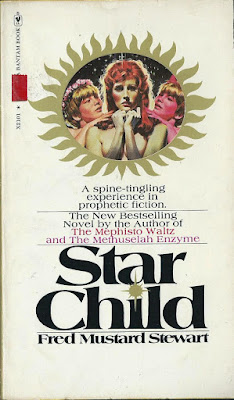Book Review: 'Beyond Earth' by Ralph Blum with Judy Blum
3 / 5 Stars
The 70s were a boom time for mass-market paperbacks devoted to the paranormal.
Bantam Books' President Oscar Dystel was particularly fond of the genre, publishing a number of Erich von Danekin's titles, including Chariots of the Gods, which was a monster seller.
The Bantam titles all shared a distinctive 'shadow' font, as seen below, that sometimes was copied by other publishers.
These books were cool !
I eagerly read them back in the early- to mid-70s, when I was in junior high and high school. They were a major aspect of 70s pop culture, and were part and parcel of a mini-industry of printed material, like Saga, and Official UFO, and Fate, and other magazines and digests that catered to the 'paranormal' readership and were always on display at the magazine racks in the supermarkets and five-and-dime stores.
The genre (arguably) reached its apogee with the release of the film Close Encounters of the Third Kind late in 1977.
'Beyond Earth' was one of the best of the 70s UFO books, and my favorite. How does it hold up when re-read more than 40 years later ?
For 'Beyond Earth', the Blums use the device of a framing narrative that opens and closes the book; this narrative deals with the so-called 'Pascagoula Incident', which took place on the night of October 11, 1973, in that city.
Two shipyard workers, Charles Hickson and Calvin Parker, were fishing at a pier on the Pascagloula River when they claimed that a large, intense, glowing blue light traveled across the water, hovered over the riverbank near them, and discharged three silver-garbed humanoid creatures (Hickson considered them 'robots').
Hickson claimed that he was paralyzed by the aliens and 'floated' into the blue light - which turned out to be a spacecraft - and subjected to a painless, but thorough, physical examination of some sort. The aliens returned Hickson to the riverbank before entering the spacecraft and departing.
The book's chapters cover, in chronological order, 'ancient' UFO sightings (according to the Blums, Cro-Magnon cave art depicts flying saucers); the 'airships' witnessed in the skies of the U.S. and Europe in the late 19th early 20th centuries; UFO sightings during the First and Second World Wars; and, of course, the postwar period and Kenneth Arnold's famous sighting of nine 'flying saucers' in June, 1947.
Other chapters deal with the U.S. government's investigations of UFOs, including the legendary Project "Blue Book", and The Condon Report. Still other chapters examine sightings in foreign countries (my favorite remains Brazilian farmer Antonio Vilas Boas, who claimed that in October 1957, he was abducted onto a UFO, and 'forced' to impregnate a stunning Alien Chick.....!).
Throughout 'Beyond Earth', Ralph Blum insists that it is critical to not dismiss even the most outlandish UFO stories out of hand, because, well, the people telling the stories seem so sincere.
Blum concludes 'Beyond Earth' by opining that the UFO Phenomenon can be attributed to three causes: extraterrestrial life forms, with advanced technologies, who are visiting the Earth; mass hallucinations; or '...a still greater mystery' unlike anything yet encountered in the human realm.
[Ralph Blum has since become a major New Age devotee, and the author of a series of books on 'Rune Magic'.]
Summing up, Blum's desire to Believe means that he buys wholeheartedly into the UFO religion, and thus 'Beyond Earth' is another UFO book that Preaches to the Converted, but is too badly flawed to be of any use to Skeptics.
But if you are in the mood to recapture some authentic 70s Nostalgia, perhaps to the accompaniment of some Emerson, Lake, and Palmer LP records, some pot, and some incense, then 'Beyond Earth' certainly delivers. And that's why I give it a 3 of 5 Stars rating.
Links of Steel, 4/28/2024
4 hours ago





















































































